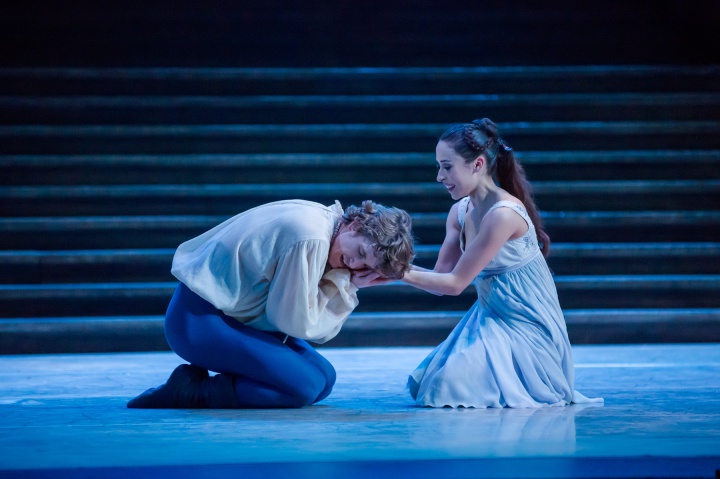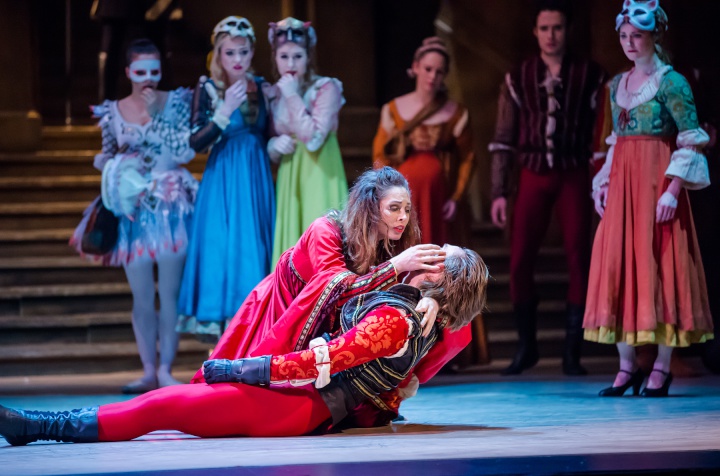Romeo & Juliet : A Rose by any Other Name Would Smell as Sweet
“What’s in a name? that which we call a rose
By
any other name would smell as sweet;
So Romeo would, were
he not Romeo call’d,
Retain that dear perfection which
he owes
Without that title. Romeo, doff thy name;
And
for that name, which is no part of thee,
Take all
myself.”

Romeo and Juliet, perhaps Shakespeare's best-known coupling, was never intended by the author to be danced, but rather to be declaimed. Nonetheless, the Royal New Zealand Ballet has accepted the challenge of this heart-touching tragedy and largely succeeded. Francesco Ventriglia, who ends his collaboration with the RNZB with this production, has proposed a choreography that matches Prokofiev’s poignant music, lyrically interpreted by the orchestra of Wellington under Hamish McKeich direction.
The prototypical love story of two young people who cannot be together greatly benefits from some inventive stage sets that transport the audience to the Renaissance in Verona - its piazza, its ballroom, and its balcony. The costumes and architecture of James Acheson (who won Academy Awards for Bernardo Bertolucci's The Last Emperor, Stephen Frears' Dangerous Liaisons, and Michael Hoffman's Restoration) immerse us within a colourful and sumptuous world in which Romeo and Juliet can live their love until the final breath.
The intensity of the two young lovers is felt viscerally, thanks to the striking artistic complicity between the dancers. Whenever Juliet (Madeleine Graham) is onstage, her every movement expresses the non-pronounced Shakespearian words. From the fear of her parents' prohibition, to the physical intensity of her passion for Romeo, and her misery after he dies, Ms Graham’s entire body fully inhabits the story. Francesco Ventriglia has capitalized on her precocious talent by offering her several solo opportunities to capture completely the purity of Juliet's innocence and naivety. Romeo (Joseph Skelton) also displays a great deal of controlled technique, with a lot of virile pirouettes, but he has yet to gain enough confidence in his work to be the complex Romeo which he will undoubtedly become by the end of this season.
Around the two leads, the supporting dancers were uniformly remarkable. The group choreography enabled Massimo Margaria as Mercutio and Filippo Valmorbida as Benevolio to make their characters real through a sense of self-assurance and technical proficiency. Paul Mathews (Tybalt) and Kohei Iwamoto (Paris) also revealed great competence, with the strong and smooth expression of their feelings gleaming whenever they danced. As Lady Capulet, Abigail Boyle gave another dimension to a relatively minor character, embodying steely disdain, despairing passion, and funereal grace with brio. This role proves her accomplishment not only as a dancer, but also as an actor of considerable range and ability in her various transformations.

Centuries later, the Shakespearian tragedy has taken on another sense, as interpreted by the RNZB. Wednesday's opening night audience greeted this production enthusiastically. This excellent dramatic rendition will surely provide ample space for Ms Graham and Mr Skelton to develop their classical interpretation of Shakespeare's tragedy in future.
Romeo and Juliet is at the St James Theatre in Wellington until 20 August, Christchurch's Isaac Theatre Royal from 25-26 August, Auckland's ASB Theatre from 30 August to 3 September, Rotorua's Civic Theatre 8-9 September, Dunedin's Regent Theatre 13-14 September, Invercargill's Civic Theatre on 17 September, Palmerston North's Regent on Broadway 21 September, and Napier's Municipal Theatre on 24 September.


 Royal Commission Covid-19 Lessons Learned: Public Submissions To The COVID-19 Inquiry Close On Sunday 27 April 2025 At Midnight
Royal Commission Covid-19 Lessons Learned: Public Submissions To The COVID-19 Inquiry Close On Sunday 27 April 2025 At Midnight Te Whatu Ora Health New Zealand: Low Risk To Public Health Following Fire At South Taranaki Hotel
Te Whatu Ora Health New Zealand: Low Risk To Public Health Following Fire At South Taranaki Hotel NZCTU: Govt Vocational Education Reforms Will Cause Massive Disruption
NZCTU: Govt Vocational Education Reforms Will Cause Massive Disruption NZ Liberation Museum - Te Arawhata: Anzac Day Commemorations In France To Remember All New Zealand Soldiers
NZ Liberation Museum - Te Arawhata: Anzac Day Commemorations In France To Remember All New Zealand Soldiers Royal Commission Covid-19 Lessons Learned: We Want To Hear From As Many People As Possible, Says COVID-19 Inquiry Chair
Royal Commission Covid-19 Lessons Learned: We Want To Hear From As Many People As Possible, Says COVID-19 Inquiry Chair My ECE: Parents Reject ECE Deregulation - 'Children’s Safety Is Not Optional'
My ECE: Parents Reject ECE Deregulation - 'Children’s Safety Is Not Optional'